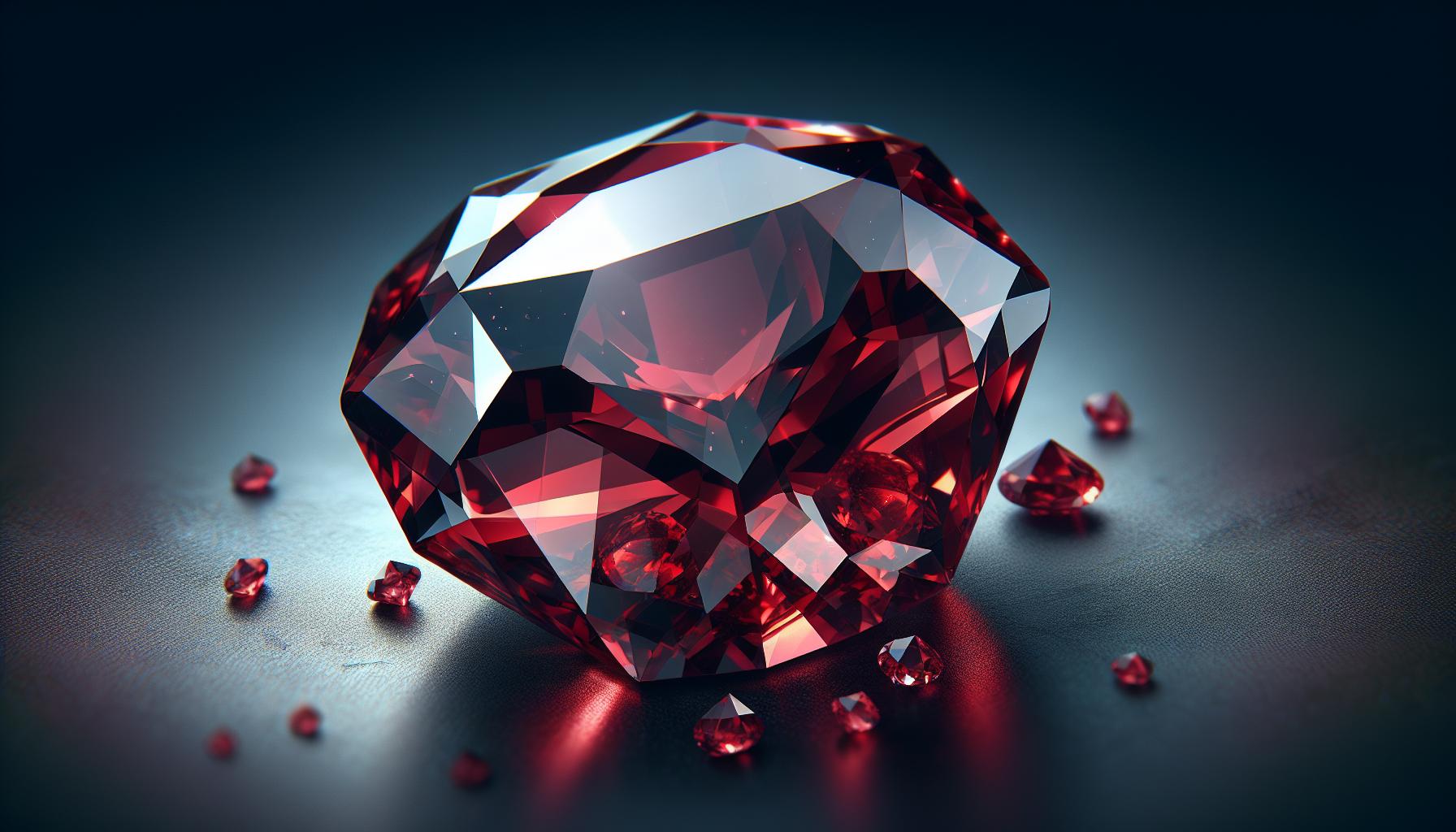Imagine holding a gemstone that radiates a deep, rich red, captivating your senses with its fiery allure. That’s the magic of the Almandine crystal, a fascinating member of the garnet family. Known for its robust energy and grounding properties, it’s a favourite among collectors and crystal enthusiasts alike.
Dive into the world of Almandine, and you’ll discover more than just its beauty. This crystal is celebrated not only for its aesthetic appeal but also for its powerful metaphysical properties. Whether you’re looking to enhance your spiritual journey or simply add a stunning piece to your collection, Almandine offers a unique blend of elegance and strength.
Key Takeaways
- Almandine Crystal Characteristics: Almandine is a deep red garnet known for its beauty and grounding metaphysical properties, making it popular among collectors and enthusiasts.
- Formation and Sources: This crystal forms in metamorphic and occasionally igneous rocks, predominantly found in India, Sri Lanka, and the USA, under high pressure and temperature.
- Physical and Chemical Properties: Almandine’s chemical formula is Fe₃Al₂(SiO₄)₃, and it ranks 7.5 on the Mohs hardness scale. Its specific gravity ranges from 4.05 to 4.3, and it has a refractive index between 1.77 and 1.83.
- Historical Significance: Historically, Almandine has been valued across ancient cultures, the Medieval period, and the Renaissance for its brilliance, hardness, and perceived protective qualities.
- Modern Uses: Almandine is widely used in jewellery for its durability and unique colour, and in industrial applications such as abrasives and waterjet cutting.
- Care Tips: Maintain Almandine’s brilliance by cleaning with mild soap and water, storing in soft pouches, and keeping it away from other gemstones to avoid scratches.
Understanding Almandine Crystal
Almandine crystal, a type of garnet, showcases rich, deep reds. It’s admired for its beauty and metaphysical benefits.
Origin and Geological Formation
Almandine forms in metamorphic rocks and occasionally in igneous rocks. Major sources include India, Sri Lanka, and the USA. It’s created under high temperatures and pressures, resulting in a durable, densely structured stone. Mines often extract almandine from schists, gneisses, and alluvial deposits.
Physical and Chemical Properties
Almandine’s formula is Fe₃Al₂(SiO₄)₃. It ranks 7.5 on the Mohs hardness scale, ensuring resistance to scratches and wear. The specific gravity ranges from 4.05 to 4.3. Almandine crystals exhibit dodecahedral or trapezohedral habits. Their refractive index falls between 1.77 and 1.83, contributing to their luster.
These combined physical and chemical properties make almandine a sought-after gemstone for both collectors and spiritual practitioners.
Historical Significance of Almandine Crystal

Almandine crystal has held a prominent place across various periods, reflecting its enduring value and multifaceted use.
Almandine in Ancient Cultures
Ancient Egyptians and Romans were known for their use of Almandine crystals. Egyptians fashioned these crystals into beads, amulets, and inlay for tombs. Romans employed them in signet rings and seals due to their hardness and brilliant colour. In India, Almandine crystals were prized for their perceived ability to channel divine energy, often used in religious ceremonies.
The Role in Medieval and Renaissance Periods
During the Medieval period, Almandine crystals symbolised nobility and protection. Knights and royalty wore these gems in their armour and jewellery, believing they offered safety in battle. In the Renaissance era, artists and scholars recognised the crystal’s potential, incorporating it into intricate artworks and scientific tools. Its inclusion in royal regalia underscored its status as a gem of distinction and power.
Almandine Crystal in Modern Usage

Almandine crystals continue to captivate with their vibrant hue and physical properties. They find various applications in modern times due to their beauty and strength.
Jewellery and Ornamental Uses
Almandine crystals, with their deep red colour, are popular in jewellery. Rings, necklaces, and bracelets often feature these gemstones. Their refractive index, ranging from 1.77 to 1.83, ensures a unique brilliance. Safe from scratches due to their 7.5 hardness on the Mohs scale, Almandine gemstones remain pristine over time.
High-quality almandine garnets, particularly those from India and Sri Lanka, are sought after for bespoke pieces. Designers favour these crystals for incorporating into jewellery for both their aesthetic and durable qualities. You might find them in vintage or contemporary designs, showcasing the versatility and timeless appeal of Almandine.
Industrial Applications
Beyond aesthetics, Almandine crystals serve industrial purposes efficiently. Abrasive materials often use these crystals due to their durability. Sandblasting and waterjet cutting industries benefit from Almandine’s hardness and specific gravity, which range from 4.05 to 4.3.
For instance,
- Abrasives: Used in sandpaper and grinding tools.
- Waterjet Cutting: Precision cutting of metals, glass, and stone.
- Filtration: Employed in water filtration systems.
These industrial applications exemplify Almandine’s utility beyond beauty. Durable and robust, the crystal’s physical characteristics make it a preferred choice for various technical processes.
Caring for Almandine Crystal
Almandine crystals, known for their durability, still require proper care to maintain their brilliance and strength. Follow these tips to ensure they remain in excellent condition.
Cleaning and Maintenance Tips
Clean your Almandine crystal with lukewarm water and mild soap. Avoid using harsh chemicals or abrasive cleaners, as they can damage the stone’s surface. Use a soft brush or cloth to gently remove dirt. Dry the crystal thoroughly with a microfibre cloth to prevent water spots. For deeper cleaning, professional services specialising in gemstone care can help.
Long-term Storage Solutions
Store your Almandine crystal in a soft pouch or a lined jewellery box to avoid scratches. Keep it separated from other gemstones and jewellery that might cause abrasions. Ensure the storage area is cool and dry, as humidity can affect the crystal’s integrity over time. For maximum protection, consider using a silica gel packet in the storage container to control moisture.
Conclusion
Almandine crystals offer a blend of historical richness and modern appeal, making them a valuable addition to any collection. Their deep red hue and durability make them ideal for both jewellery and industrial uses. By following simple care tips like gentle cleaning and proper storage, you can ensure your Almandine crystals remain in pristine condition. Whether you’re drawn to their aesthetic beauty or their metaphysical properties, these crystals are a timeless treasure worth cherishing.
Frequently Asked Questions
What is Almandine crystal?
Almandine is a type of garnet crystal known for its deep red hue and strong metaphysical properties. It has been revered since ancient times by civilizations like the Egyptians and Romans.
What are the uses of Almandine crystals?
Almandine crystals are popular in jewellery and industrial applications due to their durability and unique brilliance. They are used in various decorative and practical items.
How should I clean my Almandine crystal?
Clean your Almandine crystal using mild soap and lukewarm water. Avoid using harsh chemicals to maintain the crystal’s integrity and appearance.
How should I store my Almandine crystals?
Store Almandine crystals in a soft pouch or a lined jewellery box, keeping them away from other gemstones to prevent scratches. A cool and dry storage area is recommended.
Can Almandine crystals be used for metaphysical purposes?
Yes, Almandine crystals are known for their strong metaphysical properties and are often used in various spiritual and healing practices.
Are Almandine crystals durable?
Yes, Almandine crystals are highly durable, making them suitable for both jewellery and industrial use. Proper care and storage will help maintain their durability over time.
Should I avoid getting my Almandine crystal wet?
It’s generally safe to get Almandine crystals wet, but always use mild soap and lukewarm water and avoid soaking for long periods. Harsh chemicals or prolonged exposure to water can damage the crystal.







